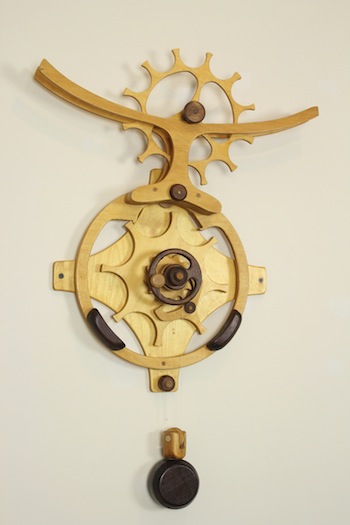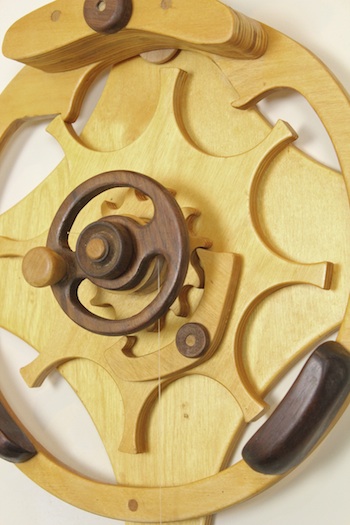David and I collected lots of video footage of his early work while preparing for his TEDx talk. We promised to start sharing some of it on the blog and this post is a first in that series. It makes all the sense to start at the beginning.
B.W. Cornwallis is David's very first wall-mounted kinetic sculpture. It was designed and built back in 1975. David was trying to answer the question that people always asked of his human-powered gadget Xylo. "But can you make it run longer?"

His first experiment to do so had been a behemoth of a design called Albert. Albert was a great learning exercise, and it worked, but it was huge, free-standing and lacked grace. The design break-through came when David started using the wall for support and B.W. is the first of a long series of wall-mounted, weight driven, kinetic sculptures.
B. W. is very much a sculpture of a mechanism, as were all of David's first experiments. He worked to develop imaginative designs using simplified escapement theory. Very basically, a falling weight attached to a string provides energy to the sculpture while the sculpture itself regulates the fall of the weight.
The rolling wheel shifts the balance of the mechanism, releasing the catch on the cog. The weight starts to fall, this turns the cog causing the cog to change angle of the ramp mechanism the rolling wheel is on. The mechanism then catches the cog, preventing further fall of the weight. The wheel continues rolling shifting balance again and the cycle repeats. This basic concept powers all of David's weight and spring driven sculptures. It is easier to see in B.W.

B. W Cornwallis was first shown at a small Connecticut craft fair and sold almost immediately, along with Inventor Released and Serendipity. David had made one of each (he really didn't expect that they would sell!) and he went back to his workshop to build additional copies. He couldn't get B. W. to work again. He quickly learned to always keep a working prototype of all his work to be able to refer back to it.
B.W. was not a very reliable design and David quickly moved on to better concepts. The next year, the original B.W. buyers returned and said it no longer worked. David offered a trade for any new designs because he really wanted his first design back. We still have the original B.W. Cornwallis and unpacked it after 35 years to video tape it. David set it up and with a minimum of tweaking, he got it working again for this video.
It was excitement all over again. It worked! It is a great piece of history!







